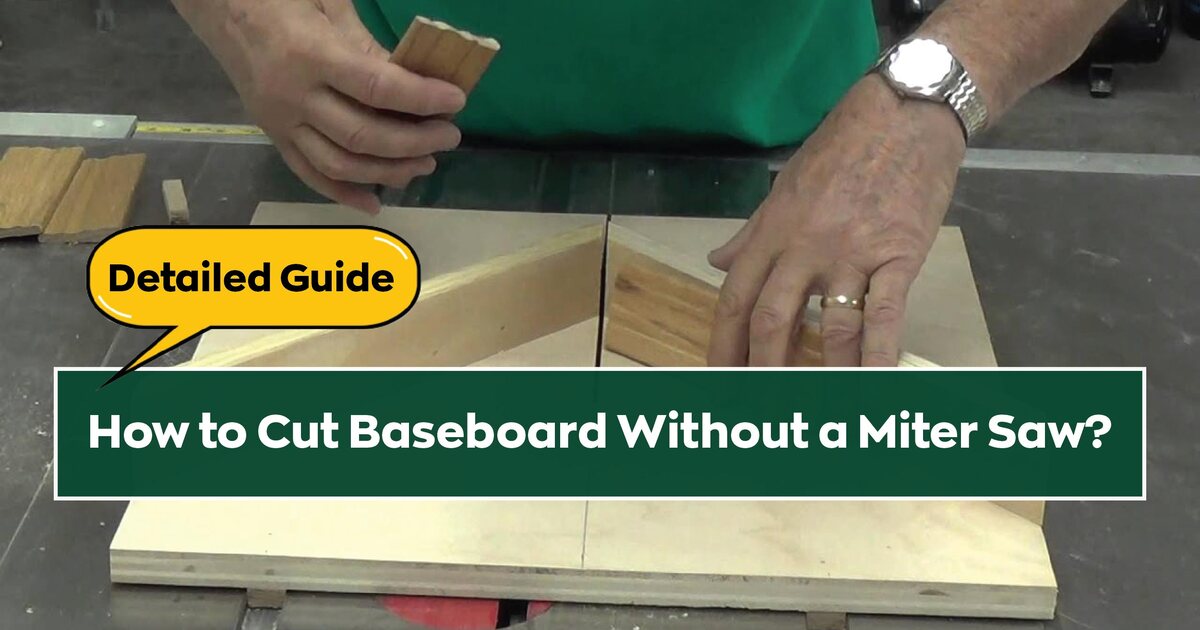Most circular saws won’t be able to cut through a 4×4 piece of wood in a single pass. Therefore, the question arises: what size circular saw to cut 4×4? The answer depends on the size of your table saw blade.
A standard 10-inch table saw, for instance, cannot make a complete cut through a 4×4 in one go. The deepest cut achievable with a 10-inch blade is approximately 3-⅛ inches.
However, if you happen to have a high-end table saw equipped with a 12-inch blade, you can indeed make a single pass cut through a 4×4, with the maximum cut depth being around 4 inches.
There are multiple techniques available for cutting 4x4s on table saws, and as you read further, We’ll provide you with some valuable tips to help you get the job done, regardless of the blade size you have.
How to Cut a 4×4 with a Circular Saw:

Step 1) Mark the Cutting Line:
Marking the cutting line is a crucial step when preparing for a cut. A precise cutline is essential for a clean and accurate cut. Even a small deviation from the line can lead to significant issues in your project.
To mark the cutline, use a speed square to guide your pencil. Place the saw’s shoe (the flat part) against the surface you’re cutting. Align the saw blade as closely as possible with the marked cutline to ensure accuracy.
Step 2) Making the First Cut:
Keep in mind that for thicker materials like a 4×4 or 6×6 post, a single pass-through cut is not possible. In this step, we will focus on making the initial cut. Hold the speed square firmly in place while gently moving the circular saw away from the wood.
Once you are satisfied with your positioning, activate the circular saw by pulling the trigger. Guide the saw along the marked cutting line using the edge of your speed square. It’s important to note that this is just the first cut, so there’s no need to apply excessive force.
Step 3) Rotate the Post:
After completing the initial cut, rotate the post toward yourself. The initial cut, also known as a kerf, will serve as a guide for repositioning your speed square accurately.
Place the saw blade, which should now be stopped, into the kerf, and position the square against the saw’s shoe. Maintain a firm grip on the square to keep it in place while you pull the blade out of the kerf. Activate the circular saw by pulling the trigger, and use the edge of the speed square to guide your next cut.
For 4×4 timber posts, you’ll need to make three separate cuts. Therefore, you’ll repeat this step to achieve that third cut, allowing you to cut through the entire post effectively.
The Cutting Depth of Circular Saws:
While circular saws are incredibly versatile tools, they do have their limitations. For smaller DIY projects around the house, circular saws can handle them with ease.
However, as the thickness of the materials you’re working with increases, as is the case with a 4×4 piece, the cutting depth becomes a crucial factor to consider.
Circular saws equipped with a standard 7 ¼-inch blade typically offer a maximum cutting depth of around 2 ½ inches. Cordless saws with slightly smaller blades, on the other hand, usually provide a depth of about 2 1/8 inches.
A 2 ½-inch cutting depth is usually sufficient for making one-pass cuts. But when you’re dealing with thicker materials like a 4×4 or 6×6 post, you’ll need a speed square and make multiple passes to achieve the desired cut.
Ripping a 4×4 on a Table Saw:
Ripping a 4×4 using a 10-inch table saw is a process similar to a cross-cut. The key difference is that you’ll only need to make two passes with the wood because your fence remains fixed, ensuring that both cuts are identical. This eliminates the need for additional clean-up passes, which is a time-saver.
Simply set the distance on your fence and lock it in place. We prefer to raise the blade so that it’s positioned slightly above halfway through the cut but not fully raised. This approach reduces the amount of material being cut during the first pass, resulting in a faster process.
Additionally, not having the blade cut through the maximum material all at once helps prevent overloading your table saw’s motor and reduces the likelihood of the blade scorching the wood.
As you guide the 4×4 along your fence, be mindful not to place your thumb where the blade will exit the rear of the wood. It’s highly recommended to use a push stick for added safety.
Other Saws for Cutting a 4×4:

Circular Saw:
While a standard circular saw can’t make a complete 4×4 cut in one pass, it’s still a useful tool. Simply mark your cut on all four sides of the 4×4 and rotate it 90 degrees after each cut. This method is effective for cross cuts, but not ideal for ripping as it may require additional sanding.
Miter Saw:
A 12-inch miter saw is an excellent choice for cutting a 4×4. It can complete the cut in a single pass. Align your cut, activate the saw, and lower it until it goes through the 4×4.
Band Saw:
A reasonably sized band saw is a handy tool for cutting a 4×4. It can handle cross-cuts, miters, and rips with ease. However, creating grooves or dados along a long 4×4 can be challenging, and a router or table saw may be more suitable for such tasks.
Radial Arm Saw:
This is another option for making a one-pass cut through a 4×4. While some consider radial arm saws to be potentially dangerous, proper use and safety precautions are essential for all power tools.
Jigsaw:
Using a jigsaw to cut a 4×4 is not recommended. The blade won’t cut all the way through and may pose a safety risk by poking out of the cut.
Reciprocating Saws:
Reciprocating saws are versatile and efficient tools, capable of cutting through a 4×4 with ease. However, achieving high accuracy may be challenging. These saws are often preferred for demolition rather than precision work.
Chainsaw:
While a chainsaw can rapidly cut through a 4×4, it’s likely to be less precise than other saws. It’s a powerful tool but may need more precision for fine woodworking.
Hand Saws:
Various hand saws can cut a 4×4, but they require manual effort and time. Using hand saws can be labor-intensive and time-consuming compared to power tools.
Scroll Saw:
A scroll saw is not suitable for cutting through a 4×4. It’s typically used for smaller, intricate projects that require precision.
Guidelines for Precision and Safety When Cutting a 4×4:
- Ensure the saw’s blade depth is fully lowered before making any adjustments.
- When marking, avoid using single points and instead use “tick” or “crow’s foot” marks to clearly identify the cutting location.
- Maintain a safe distance from the saw while it is in operation.
- Prior to making any modifications, always ensure that the saw is disconnected from the power source.
- In the event a piece becomes completely detached from the wood, allow it to fall naturally. Do not attempt to catch it while holding a running saw.
- Avoid standing directly behind or in close proximity to the running blade to prevent potential injuries in the event of kickback. Kickback is an extremely hazardous situation that must be avoided at all costs.
- The application of masking tape before marking can reduce splinters and result in a smoother finish.
- Make certain to cut slightly beyond the marked line to achieve the correct dimensions for the wood piece you intend to use.
- Utilize a rasp to refine and smoothen the cut after sawing. Alternatively, a hand sander or sandpaper can also serve the same purpose.
- Once the saw is activated, keep it steady and refrain from attempting to forcefully push it back in case it deviates from the intended path.
- Excessive force can create pinch points in the wood, potentially causing damage to both the user and the saw.
Bottom Line: What Size Circular Saw to Cut 4×4?
In conclusion, selecting the right size circular saw for cutting 4×4 lumber is essential for a safe and efficient woodworking experience. The process involves a few straightforward steps, from choosing the appropriate blade to setting up the saw and ensuring proper safety precautions.
By following these steps and considering the tips we’ve discussed, you can confidently tackle your 4×4 cutting tasks.
Remember that the size of the circular saw matters; opting for a saw with a sufficient blade diameter and motor power is crucial to handling the thickness of 4×4 materials effectively.
Safety should be your top priority, and using safety gear, maintaining a stable work surface, and securing the workpiece are non-negotiable steps.
Additionally, understanding the limitations and potential challenges of cutting 4×4 lumber will aid in achieving clean and precise cuts. With the right tools, knowledge, and a commitment to safety, you’ll be well-equipped to conquer your woodworking projects that involve 4×4 materials.
So, whether you’re building a deck, framing a structure, or working on other projects, the right size circular saw, used with care and precision, will be your trusted ally in creating woodworking masterpieces. Happy woodworking!
FAQs:
What Diameter of a Circular Saw Blade is Required to Cut a 4×4 Piece of Wood?
When it comes to cutting a 4×4, the two most commonly used circular saw blade sizes are the 7 ¼-inch blade, which can cut up to 2 ½ inches in depth, and the smaller 6 ½-inch blade with a maximum depth of 2 1/8 inches (at 90 degrees).
Keep in mind that if you’re cutting at an angle, the cutting depth of these blades will be further reduced. Therefore, it’s important to note that a standard blade cannot cut through a 4×4 in one go. However, you can cut a 4×4 by making multiple passes from all four sides using either of these blade sizes.
What Causes a Circular Saw to Become Jammed?
A circular saw experiences issues and becomes stuck when the blade is adjusted to a depth that’s excessively deep. Having the blade at the right depth not only reduces the risk of kickbacks and binding but also enhances safety and effectiveness when cutting.
Moreover, if the blade is set too deep, it’s more likely to bend and wobble, resulting in uneven cuts and posing a potential safety hazard.
Is it Possible to Utilize a Circular Saw for Metal Cutting?
With the use of a circular saw blade designed for ferrous metals, you’ll find it feasible to cut through mild steel sections with a thickness of around 3/8 inches.
It’s vital to avoid employing standard masonry blades for metal cutting, as they are specifically engineered for cutting materials such as wood and plastic. Using regular blades for cutting concrete or metal can lead to damaged or chipped teeth, posing potential risks of injuries.
Related Posts:






